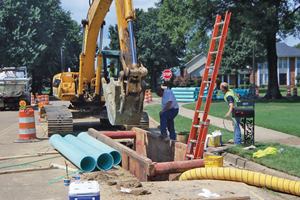Horizontal directional drilling for gravity sewers
City’s satisfied with process that consistently achieves slopes of less than 1%
From Public Works
Three years ago, the City of Germantown, Tenn., began making plans to install a new gravity sewer system in a 1970s-era subdivision to relieve an overburdened concrete sewer line. The sewer was running near full capacity every day and occasionally overflowed during heavy rains. And that was before a zoning ordinance allowed five-story buildings to be built in the sewer basin’s upper reaches.
“We wanted to improve service for existing customers and make sure future developments aren’t hindered,” says Public Services Director Bo Mills, who is also the American Public Works Association’s Region III director. “We decided to create a bypass to collect and divert the flow from this basin and pump it away from the heavily
charged area.”
Ultimately, the bypass will consist of 1,900 feet of gravity sewer leading to a pump station and another 2,000 feet of force main going to an outfall sewer.











